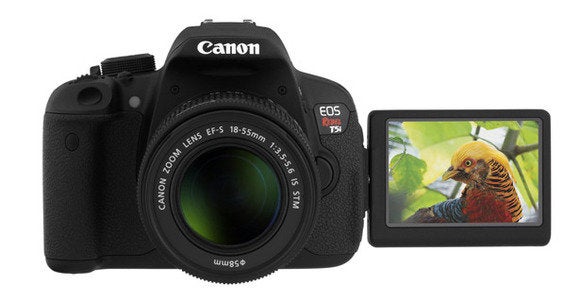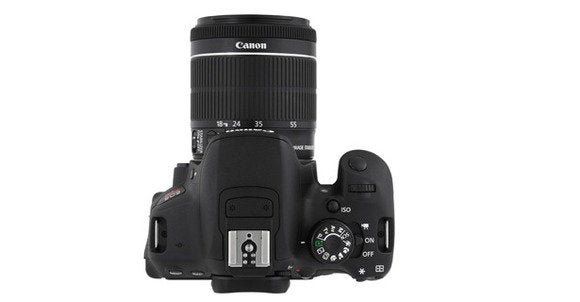
AT A GLANCE
Among Canon’s entry-level SLR offerings, the Canon EOS Rebel T5i is the strongest pick if you’re interested in capturing video as well as still images. Its articulating, swing-out high-resolution touchscreen display really helps when capturing video and stills at a variety of angles. The camera can auto-focus while recording a movie, and it has an external microphone jack for capturing audio, too. The T5i ($849 with 18-55mm STM lens) is considered the step-up model from the T5—each represents an evolutionary refresh of earlier Canon cameras, as opposed to a dramatic upgrade.
Design
While the T5i is slightly larger and heavier than the T5, it also shares many features. Both models share the same 18-megapixel resolution and sensor size. However, the T5i uses a newer DIGIC 5 processor; the T5 uses a DIGIC 4. The standard 18-55mm IS (Image Stabilizer) kit lens uses Canon’s STM Stepper Motor technology, for quieter operation during video capture. The lens has a different physical appearance fro the 18-55mm IS lens that comes with the T5.
The camera has a deep, easy-to-handle right grip. At the top sits an embossed, easy-to-read 360-degree dial, with standard settings for manual, aperture, shutter priority, automatic, and program modes, as well as selections for enhanced modes (such as macro, landscape, creative auto, sports, and portrait), and scene modes for specialized shooting (Night Portrait, Handheld Night Scene, and HDR Backlight Control). To navigate the exposure settings, you use a combination of the horizontal scroll wheel on top of the camera and the Q button at the back. The dial itself is better defined and easier to read and turn than on the T5.
Both models have a switch alongside the dial for power on/off. The T5i adds a third option, movie mode, to this switch, but I’d have preferred to see a dedicated button instead. While shooting, I found it a little awkward to switch in and out of movie mode on the fly with my fingers. I appreciated that the ISO control was a dedicated button, and not just an option accessible via the on-screen display. However, the button’s location and relatively close proximity to the scroll wheel that’s used to adjust the ISO made this button more awkward to use than I’d have expected. Along the right side sits a compartment for storing an SD card.
Overall, I liked the Canon interface, even if it remains less visual and graphical than what you’ll find on some of its competitors. And I especially liked navigating the on-screen display on the high-resolution touchscreen—even if it got tiresome having to first tap either the physical Q button or the bottom left corner of the display itself every time I wanted to change a setting. At least Canon lets you use alternate using the physical buttons and the onscreen display. This is incredibly helpful, since sometimes you may find it faster or more intuitive to one or the other.
The articulating display is one of my favorite features on the T5i. I’ve long been a fan of Canon’s flip-out display—it can flip up and down to allow unique camera angles and maximum shooting creativity. Even better: The display can flip 180-degrees in the same direction as you’re shooting, making the T5i a terrific tool for selfies. The included 18mm-55mm EFS STM kit lens provides a wide enough angle to capture everything from those selfies to landscapes. And the camera remains light enough to easily hold in one hand.
Capture
Like the T5, the T5i has a 9-point auto-focus. The auto-focus uses contrast-detection cross-type, which helps the camera better distinguish what you’re capturing. Still, with just those nine points of auto-focus, I felt a bit limited in range when attempting to creatively frame images. Adjusting focus is easy: Tap the focus button at the far right top corner, then use the scroll wheel at top, or the four-way buttons at bottom, to cycle among the focus points.
I found Live View focus frustrating—the camera often needed more time to lock in than a modern-day smartphone. You can, at least, tap anywhere on the screen to select a focus point, as we’re used to doing now with our phones. Tapping the Q button at the upper-right brings up shooting mode adjustments, distributed in a U-shape around the display.
When I kicked the camera into a high-speed shooting mode, I liked its five frames per second capture speed. While that’s no competition with the speed of higher-end Canon models aimed at enthusiasts and pros, it’s still suitable for capturing fast-moving action, such as speedy toddler or an athletic teen. If you know how to time your capture, you should be able to get a leap on the balance beam or a slide into home.
I did notice a difference in image quality between the T5i and the T5, particularly as I pushed the ISO level higher. Still, neither camera is a good choice for truly low-light shooting, with ISO 800 being relatively noise-free and sharp, and ISO 1600 about as high as you’d want to push it. The T5i has higher ISO options, to 12800 (twice that of the T5), but be prepared for noise to increase the higher you go, and a loss of detail and sharpness.
Overall, images look good. I found accurate color and sharp detail at all focal lengths. Occasionally, I noticed that the Program mode tended toward brighter exposures than I’d expected.



No comments:
Post a Comment